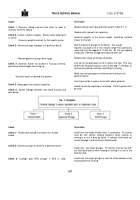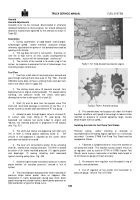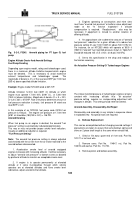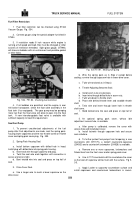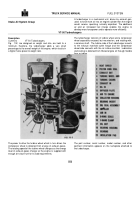TM-5-3805-254-14-P-2 - Page 552 of 894
TRUCK SERVICE MANUAL
FUEL SYSTEM
4.
Replace pipe plug when idle speed is correct.
7.
Some problems with excessive vibrations have
occurred at engine idle speeds particularly in truck
applications that also have power takeoffs.
This is
particularly true of applications with cement mixers.
8.
In these cases it has been found that a substantial
amount of vibration can be eliminated by an adjustment of
the engine idle speed to compensate for component cyclic
vibrations p)resent In each particular application.
9.
These are recommended speeds and are intended as
reference points.
Slight deviations can be made from these
speeds although it should be noted that extreme care must be
taken so that new problems are not created by extreme
variations in idle speed.
10.
Problems such as difficult gear engagement can be
encountered with excessively high idle speeds.
Poor load
pickup can be a problem if idle speeds are adjusted to low.
12.
Before concluding that the governor plunger is the
cause of idle surge, check the weight assist protrusion against
specifications.
High Speed
1.
A means of loading the engine must be used to
perform in this check.
The tachometer and fuel manifold
pressure gauge must be of high accuracy.
The engine fuel
system must be purged of all air and at operating temperature.
2.
The preferred method of checking governor setting is
to "load" the engine on an engine or chassis dynamometer.
3.
Maximum
engine
speed
is adjusted
by adding
or
removing shims under the high speed governor spring.
Normally, this adjustment is made on the fuel pump test stand
as the fuel pump is calibrated and does not need to be
changed on the engine.
Cutoff Setting
1.
At full throttle increase load until the speed is )pulled
down to at least 100 rpm below engine rated speed, then
decrease the load gradually while observing the fuel manifold
pressure gauge.
(The fuel manifold pressure will increase with
decreasing load until the governor begins restricting fuel and
then the pressure will begin decreasing with decreasing load.)
2.
Continue decreasing load until fuel manifold pressure
reaches its peak and decreases 1 to 2 psi.
This is the so
called
"governor
goes
dead",
"governor
break
or "governor
cutoff" point.
This speed is between 30 to 50 rpm higher than
engine rated speed to assure that governor restricting before
rated speed.
(Example1 on a 2100 rpm engine this speed
should be 2130 to 2150 rpm.)
3.
If the governor cutoff point is higher or lower than
specifications, shims should be removed or added from behind
governor high speed spring accordingly.
4.
Recheck the governor cutoff point adjustment.
Engine Hi-idle or Maximum No-Load Speed
1.
Operate engine to purge all air from fuel system arind
bring up to operating temperature.
2.
With transmission in neutral or the clutch disengaged,
open throttle and hold fully open.
Note the inaxilLimum engine
speed.
This speed will be 10 to 12% greater than the
governor "cutoff" speed, depending upon engine parasitic
loads (fans, pumps, etc.)
3.
This check
should not be used to check or make
governor speed adjustments.
This check is of secondary
importance and must be considered as such unless the no-
load speed is significantly greater than specifications in which
case the governor assembly should be examined for
malfunction or improper parts.
Checking and Adjusting Fuel Manifold Pressure
Listed below are three methods of checking fuel manifold
pressure.
The engine must be at operating temperature and
fuel system purged of all air.
1.
The preferred method of checking engine manifold
pressure is to load engine on an engine or chassis
dynamometer as follows.
a.
Check governor cutoff as detailed previously.
b.
At full throttle, increase load until engine is pulled
down to rated speed (accurate tachometer must be used).
Read fuel manifold pressure.
If engine fuel manifold pressure
is below minimum or above maximum specifications, make the
following adjustments.
To Raise Pressure
(1)
Screw out maximum throttle opening stop screw and
utilize throttle restriction thay may be present.
CAUTION
Do not screw the screw out beyond maximum throttle
opening point otherwise a dead throttle travel may occur.
(2)
Remove throttle shaft and add fuel adjusting shims as
required.
To Decrease Pressure (1) Remove throttle shaft and
remove shims as required.
CAUTION
Under no circumstances should engine manifold pressure
be set above maximum specifications.
Doing so will void
engine warranty.
(2)
It should not be necessary to adjust fuel manifold
pressure on a newly calibrated pump more than + 2 psi [0.14
kg/sq. cm].
If adjustments greater than this are required, fuel
pump test, injector test stand or engine problems may exist.
2.
The next best method of checking maximum engine
fuel manifold pressure is to note maximum pressure while
accelerating at full throttle when going up through the
transmission ratios.
With proper gauge snubbing, this method
can be relatively accurate, especially if a heavy load
547
Back to Top

